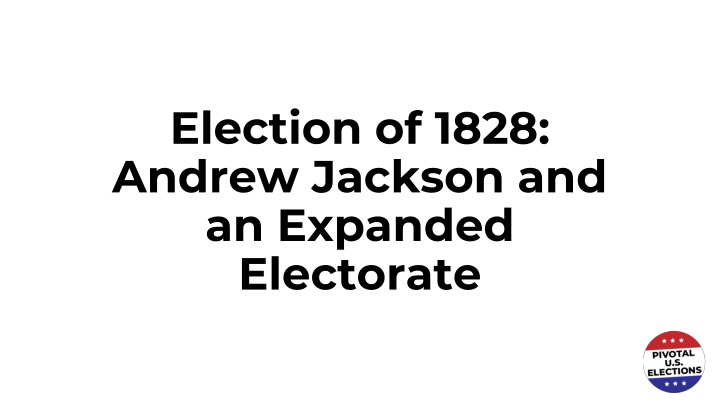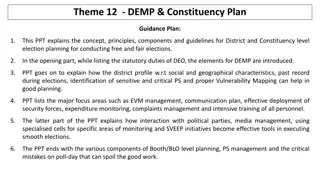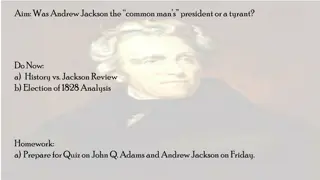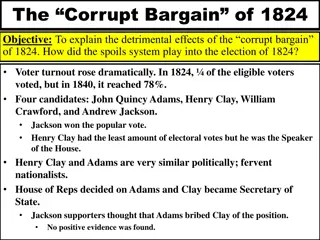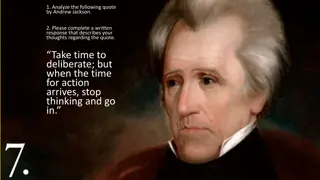The Election of 1828: Andrew Jackson and the Era of the Common Man
The Election of 1828 marked a significant shift towards democratization in the United States as Andrew Jackson's popularity led to an expanded electorate. Changes in voting requirements and campaign styles made elections more accessible and eventful. The intense campaign between Jackson and John Quincy Adams reflected a growing emphasis on appealing to the common man's interests. Overall, the period was characterized by increased political participation and the rise of the common man in shaping American politics.
Download Presentation

Please find below an Image/Link to download the presentation.
The content on the website is provided AS IS for your information and personal use only. It may not be sold, licensed, or shared on other websites without obtaining consent from the author.If you encounter any issues during the download, it is possible that the publisher has removed the file from their server.
You are allowed to download the files provided on this website for personal or commercial use, subject to the condition that they are used lawfully. All files are the property of their respective owners.
The content on the website is provided AS IS for your information and personal use only. It may not be sold, licensed, or shared on other websites without obtaining consent from the author.
E N D
Presentation Transcript
Election of 1828: Andrew Jackson and an Expanded Electorate
Essential Question How accurate is the characterization of this period in U.S. history as the era of the common man ?
Key Ideas Results from the previous presidential election in 1824, in which Andrew Jackson won the popular vote but did not win the presidency, left many people upset that a corrupt elite had, allegedly, rigged the outcome. This led to calls to change the way voting worked in the United States. Changes on several levels saw more people able to participate in elections: The end of property requirements to vote meant that more men were eligible to vote. The increase in the number of states choosing presidential electors by popular votes rather than by vote of the state legislators contributed to the increasingly democratic nature of elections.
Key Ideas Changes in campaign styles made political contests public events that involved spectacle and debates, manipulation of candidates images to appeal to voters, and broadened use of the press. The 1828 campaign was particularly personal. Character attacks were as common as policy-based campaigning. Some described the campaign as pitting a president who writes against a president who fights. Others, on both sides, warned of the danger of emerging tyranny.
Candidates and Outcome Jackson 178 Adams 83 Andrew Jackson (Democrat) John Quincy Adams (National Republican)
Warm-Up Resolution No. 5 Acts Passed at the Regular Session of the Sixteenth General Assembly of the State of Tennessee October 7, 1825
Resolution No. 5 Acts Passed at the Regular Session of the Sixteenth General Assembly of the State of Tennessee October 7, 1825 No. 5 RESOLUTION, relative to the reception of general Jackson. Resolved, as an evidence of the respect and attachment entertained by this Legislature, in common with our fellow-citizens, towards general ANDREW JACKSON, for his high personal qualifications, and numerous and important services rendered to his country, that the two branches of this General Assembly will receive him on the day next after his arrival at the seat of government, at 12 o clock, in the representative hall. Resolved, That one or both of the speakers, on behalf of the two houses, shall deliver, at such time, to general Jackson, an address expressive of their high personal regard, and the great satisfaction they feel in relation to the course he pursued, during the pending of the late presidential election. Resolved, That a joint select committee be appointed to wait upon general Jackson, on his arrival at the seat of government, to inform him of the foregoing resolution, and conduct him within the bar of the house of representatives. WM. BRADY, Speaker of the House of Representatives. Speaker of the Senate. J.P. ERWIN, Clerk, of the H. Rep. Clerk of the Senate. Adopted October 7, 1825. Acts Passed at the Regular Session of the Sixteenth General Assembly of the State of Tennessee, 363-364. (Knoxville, TN: Weiskell & Brown and A.P. Maury, 1826).
